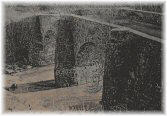|
About the Area: Loudoun County
Loudoun County was established in 1757 from Fairfax County. The county is named for John Campbell, Fourth Earl of Loudoun and Governor of Virginia
from 1756 59. Western settlement began in the 1720s and 1730s with Quakers, Scots-Irish, Germans and others moving south from Pennsylvania and
Maryland, and by English settlers and African slaves moving upriver from Tidewater.
By the time of the American Revolution, Loudoun was the most populous county in Virginia. During the War of 1812, important
federal documents and
government archives were evacuated from Washington and stored at Leesburg for safe keeping. Local tradition holds that these documents were
stored at Rokeby House and thus that Leesburg was briefly the capital of the United States.
Early in the Civil War, the Battle of Balls Bluff took place near Leesburg on October 21, 1861. Future jurist Oliver Wendell Holmes, Jr.
was critically wounded in that battle along the Potomac River. During the Gettysburg Campaign in June 1863, Confederate Major General J.E.B.
Stuart and Union cavalry clashed in the battles of Aldie, Middleburg, and Upperville. Confederate John S. Mosby based his operations
in Loudoun and adjoining Fauquier County. (For a more in-depth account of the history of Loudoun County during the Civil War, see
Loudoun County
and the Civil War.)
Today, Loudoun County is home to over 270,000 people, (figure quoted as of July 2006, by census.gov), which is a 58 percent increase over the
2000 figure of 169,599. That increase makes the county the fastest growing in the United States during that period. Its county seat is Leesburg,
which has been county seat for 250 of the last 251 years.
- Notable people from Loudoun County:
- James Monroe constructed and resided at Oak Hill near Aldie after his presidency.
- Civil War Brigadier General Robert H. Chilton (Chief of Staff under Robert E. Lee) was a native of Loudoun County.
- World War II general George C. Marshall resided at Dodona Manor in Leesburg.
- Entertainer Arthur Godfrey lived near historic Waterford, Virginia.
- Loudoun County is also notable for being the birthplace of Julia Neale Jackson, mother of Stonewall Jackson, and Susan Catherine Koerner, mother of the Wright Brothers.
- Historic sites in Loudoun County:
The content contained herein does not necessarily represent the position of the NSDAR.
Hyperlinks to other sites are not the responsibility of the NSDAR, the state organizations, or individual DAR chapters
| 










